[MEET THE EXPERT] - Medical Cluster
[MEET THE EXPERT] - Medical Cluster
[MEET THE EXPERT] - Medical Cluster
Sie wollen auch ein ePaper? Erhöhen Sie die Reichweite Ihrer Titel.
YUMPU macht aus Druck-PDFs automatisch weboptimierte ePaper, die Google liebt.
Design excellence tools used to optimise New <strong>Medical</strong> Product Development:<br />
illustration on the new “Viper F2” system<br />
Henri Défossez, PhD; DePuy Spine Sàrl, Johnson & Johnson; Le Locle, Switzerland<br />
Introduction:<br />
Design Excellence (DEX) tools have been widely<br />
used in the industry; and as such are integrally part<br />
of the New Product Development (NPD) process at<br />
DePuy Johnson & Johnson. The appropriate<br />
selection and use of DEX tools significantly<br />
facilitate the development (design, manufacture,<br />
marketing ...) of new medical products. This is illustrated<br />
with the recent development of the new<br />
Viper F2 system; an orthopaedic<br />
spinal implant system<br />
dedicated to transfacet pedicular<br />
fusion treatment, as shown in<br />
figure 1).<br />
Fig. 1: Viper F2.<br />
DEX Overview:<br />
A plethora of DEX tools are available at various<br />
stages of the new product development; as<br />
illustrated in figure 2 representing the linkage<br />
between Design Excellence and New product<br />
Development process of <strong>Medical</strong> Devices and<br />
Diagnostics. Since every project is different and<br />
often tends to evolve in scope throughout time; it is<br />
appropriate to regularly review and assess which<br />
tools are most relevant to support the project<br />
throughout its lifecycle. For the Viper F2 project,<br />
figure 3 presents those most important tools<br />
selected during the project phases.<br />
Fig. 2: Linkage between DEX and NPD.<br />
Define Phase: Measure Phase:<br />
Business Case Definition,<br />
Market Research & Value<br />
Proposition, Multi Generational<br />
Plan, Gant Chart Definition<br />
Benchmarking with Pugh<br />
Matrix, Focus groups with<br />
Small & large internal/external<br />
VOC groups, Top-level Risk<br />
Assessment<br />
Analyze Phase: Design / VV phases:<br />
Detailed Risk Management Plan<br />
and Report (DFMEA+), Product<br />
Map (“technical” usage map),<br />
Preliminary Surgical Technique<br />
and training plan<br />
Design of Experiments coupled<br />
with Manufacturing Process<br />
validation, Brainstorming K,<br />
Biomechanical testing with<br />
ANOVA, CTQs “Plus”<br />
Fig. 3: Main DEX tools employed as part of the<br />
Viper F2 development.<br />
Main outcomes:<br />
The following tools were found to be most<br />
successful at developing the correct product for<br />
market penetration while reducing the number of<br />
design iterations and manufacturing validations:<br />
• Cost analysis & Pugh Matrix & Multi<br />
Generation Plan: this enabled to develop early<br />
on a robust rationale to develop the right<br />
project; with a specified scope with associated<br />
in roll-out phases, so to avoid project scope<br />
creep and incorrect product portfolio allocation.<br />
• Risk Management Plan & Product Map: the<br />
new levels of details within the tools employed<br />
allowed to establish an unprecedented technical<br />
verification/validation program.<br />
• Design of Experiments & Process Quantification:<br />
it was possible to start even at the<br />
concept phase to focus on critical mechanical<br />
features of the system to be designed and<br />
validated for manufacture.<br />
12


![[MEET THE EXPERT] - Medical Cluster](https://img.yumpu.com/8021008/12/500x640/meet-the-expert-medical-cluster.jpg)
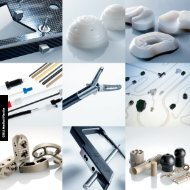
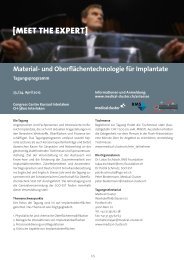

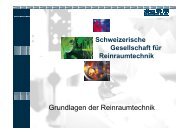
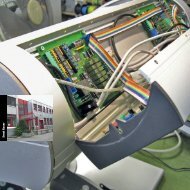

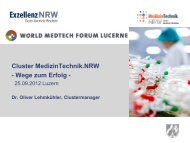
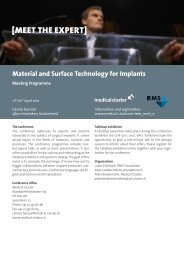
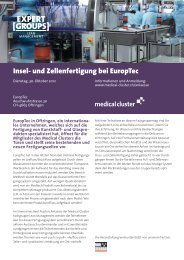
![[MEET THE EXPERT] - Medical Cluster](https://img.yumpu.com/4254707/1/184x260/meet-the-expert-medical-cluster.jpg?quality=85)